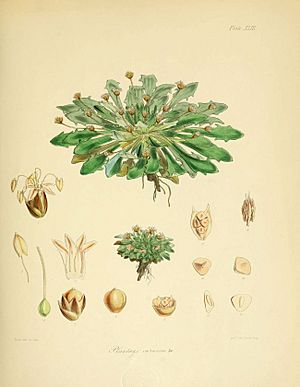Plantago triantha facts for kids
Quick facts for kids Plantago triantha |
|
|---|---|
 |
|
| P. triantha as P.carnosa R.Br. (nom. illeg.) Plate XLIII | |
| Conservation status | |
|
Invalid status (NZ TCS)
|
|
| Scientific classification | |
| Genus: |
Plantago
|
| Species: |
triantha
|
| Synonyms | |
|
Plantago carnosa R.Br (1810) non Lam. (1791) |
|
Plantago triantha is a small plant that lives for only one year. It belongs to the plant family called Plantaginaceae. You can find this interesting plant growing in two main places: Tasmania and the Auckland Islands.
Is Plantago triantha in Danger?
Plantago triantha has a special conservation status in New Zealand. Since 2009, it has been listed as "At Risk — Naturally Uncommon" under the New Zealand Threat Classification System. This means the plant is not very common in New Zealand.
It is considered "naturally uncommon" because it only grows in a few specific areas there. However, it is doing well in other parts of the world. This classification was checked again in 2012 and 2018, and the plant's status remained the same.
How Plantago triantha Got Its Name
The scientific name of a plant is very important. It helps scientists around the world know exactly which plant they are talking about.
Plantago triantha was first described in 1810 by a botanist named Robert Brown. He called it Plantago carnosa. However, this name was not allowed. Another scientist, Jean-Baptiste Lamarck, had already used the name Plantago carnosa for a different plant back in 1792.
Because of this, Robert Brown's name for the plant was considered "illegal" in the world of botany. The plant finally received its proper and official name, Plantago triantha, in 1824. This correct name was given by Kurt Polycarp Joachim Sprengel.

